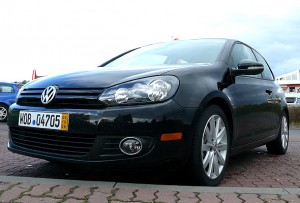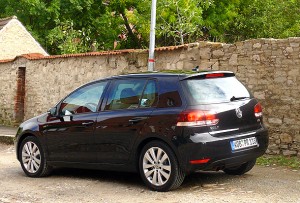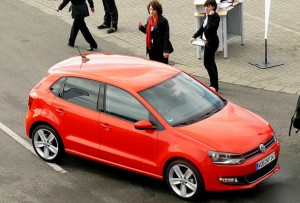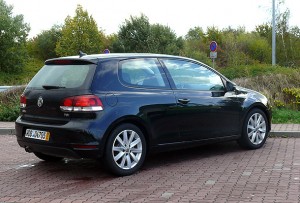Newest Golf offers advanced turbodiesel
WOLFSBURG, Germany—Our Volkswagen Golf TDI was sailing along the E-30 stretch of Germany’s network of autobahns, from Wolfsburg toward Dresden, and since I was driving, I appreciated the smoothness. In a half-dozen previous opportunities, I have always enjoyed the chance to drive quality cars at the unrestricted speed limits, and this was more of the same.
As I glanced at the instruments, something seemed restrictive, however. Having grown accustomed to the metric instruments of European cars, I knew that when you get to an astronomical figure of kilometers per hour, you may be getting up there in miles per hour as well. For instance, 210 km. per hour is about 135 mph, and 245 km. per hour is about 150 mph. While the little 2.0-liter 4-cylinder turbo-diesel engine in our 2010 Golf had tremendous low-end power, it was just about out of power. With the speedometer indicating 125, I figured it wasn’t much over 70 mph, so our feeling of speed must be an illusion, because we cruise at 70 mph on U.S. freeways.
I mentioned it to my co-driver, because the scenery was passing by pretty swiftly, so we checked the speedometer again. Sure enough, while we were trying to calculate from metric, the Germans had given us a Golf with its speedometer in miles per hour. We got a good laugh out of cruising along at 125 mpg, and complaining about not having more power!
The Golf is in its seventh edition for the 2010 model year, and, as usual, its changes are evolutionary rather than revolutionary. Switching to a horizontal grille in a more rounded frontal area improves aerodynamics, with refined edges and seams all around, the key to the new car is its technology. That is the reason the new Golf is one of the finalists for the North American Car of the Year competition, and, indirectly, the reason Volkswagen invited a selection of North American auto journalists to try the new Golf in its homeland.
As tours go, this one was fantastic. We flew to Hanover, then drove to Wolfsburg, which is dominated by Volkwagen’s Autostadt — a city within the city that houses Volkswagen’s factory, distribution, museum, and sales headquarters. From Wolfsburg we drove to VW’s test facility to drive some of the vehicles available in Europe but not yet in the U.S., and sampled some soon-to-come models, such as a hybrid with an electric system linked to a small turbo-diesel, which is certain to get something in the ballpark of 100 miles per gallon. There is also a plug-in hybrid, which, VW says, will be available within a year.
The next day we drove from Wolfsburg to Dresden, to visit another assembly plant where the luxury Phaeton — no longer brought to the U.S. — is put together by hand. After that tour, we drove northward on E-65, another autobahn, to Berlin. We only had an hour and a half of free time in Berlin, and I wished it was much more because it is such a beautiful, classical and mysterious city.
During the trip, there was ample opportunity to listen to presentations by Volkswagen executives, as there was to drive different vehicles, and the overall intention was clearly to show us all the direction Volkswagen is going for its future in the North American marketplace.
Diesel technology is a key. Diesels provide more torque than much larger gasoline engines, and turbocharging increases the power to more usable acceleration and U.S.-like quickness. But American consumers are fickle, and their desire for such superb, fuel-efficient technology seems directly traceable to the cost of gasoline. When it goes up past $3 a gallon, high-mpg cars sell like popcorn; as soon as fuel prices drop to the lower $2 range, people seem to think they can get by with less-fuel-efficient vehicles. VW is focused on a leaner and cleaner future.
“The key word is downsizing, and I don’t mean just small, but powerful,” said Dr. Hermann Middendorf, the head of engine development. “By the reduction of displacement and the number of cylinders, combined with direct injection and turbocharging, we can get more power with less consumption.”
The 2010 Golf retains the 2.5-liter 5-cylinder engine, which has been upgraded significantly with direct injection, and the 2.0 turbo-diesel, which comes either with a 6-speed manual or the DSG. “The DSG shifts at lower revs,” said Middendorf. “We have gotten a 20-percent improvement with our new engines, and an additional 10 percent with the DSG.”
Middendorf indicated that along with the 3.0-liter V6 turbo-diesel in the Touareg SUV, the available 2.0 turbo-diesel in the Jetta and now the Golf in the U.S., will be joined by smaller turbo-diesels in the near future — engines that already are available in Europe, where consumers are more consumed with high gas-mileage vehicles as well as durable and potent machines.
VW has 1.6 and 1.4 liter turbo-diesels already running in Europe. The 1.4 has been selling well since 2006, and the 1.4 and 2.0 have won European engine-of-the-year honors for four straight years. New on the market in Europe and Asia is a 1.2-liter.
German car-makers are as far advanced in diesel technology as the Japanese are in hybrids. It might be most effective to combine the two, and VW, along with Audi, which it owns, might be taking the lead in combining the two. At the Frankfurt auto show in September, VW displayed a new 1.2-liter, 3-cylinder turbo-diesel hybrid. Another car, for display only, had a 0.8-liter 2-cylinder turbo-diesel — essentially half of the 1.6-liter 4-cylinder — connected to an electrical system for a 108-horsepower hybrid.
Audi’s technology includes the 2.0 turbocharged gas engine and the direct-sequential-manual transmission — a clutchless unit that has two clutches internally, gripping alternating gears and shifting smoothly and instantaneously. That DSG (direct sequential gearbox) has been a huge element, along with the direct injection and turbocharging, in achieving sensational fuel economy as well as surprising power for the smaller Volkswagen engines.
Volkswagen is clearly focused on the future. It used to have a commanding share of U.S. import sales, and while that has faded in recent years, VW continues to dominate markets in Europe, China, Central America and South America, and Dr. Joakim Heizmann said VW is determined to regain its solid market share in the U.S. as well.
“We are investing $1 billion in our new Chattanooga, Tenn., plant, and we will offer 2,000 new jobs there,” said Heizmann. “We believe we have a prominent future in the U.S., and the centerpiece of our strategy is to build fascinating cars for the needs and dreams of American drivers.”
To that end, VW has secretive plans to bujild a new midsize sedan, beyond the Jetta and Passat, to be introduced as a 2011 model. It will be built in the soon-to-be-completed Chattanooga plant, and aimed exclusively for the U.S. and Canadian markets.
Now if we can just find a good stretch of rural freeway and convince the government to eliminate speed limits.
Comments
Tell me what you're thinking...
and oh, if you want a pic to show with your comment, go get a gravatar!






 John Gilbert is a lifetime Minnesotan and career journalist, specializing in cars and sports during and since spending 30 years at the Minneapolis Tribune, now the Star Tribune. More recently, he has continued translating the high-tech world of autos and sharing his passionate insights as a freelance writer/photographer/broadcaster. A member of the prestigious North American Car and Truck of the Year jury since 1993. John can be heard Monday-Friday from 9-11am on 610 KDAL(www.kdal610.com) on the "John Gilbert Show," and writes a column in the Duluth Reader.
John Gilbert is a lifetime Minnesotan and career journalist, specializing in cars and sports during and since spending 30 years at the Minneapolis Tribune, now the Star Tribune. More recently, he has continued translating the high-tech world of autos and sharing his passionate insights as a freelance writer/photographer/broadcaster. A member of the prestigious North American Car and Truck of the Year jury since 1993. John can be heard Monday-Friday from 9-11am on 610 KDAL(www.kdal610.com) on the "John Gilbert Show," and writes a column in the Duluth Reader.